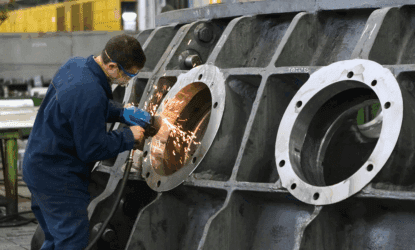 Understanding Scope 1 and 2 greenhouse gas emissions
Understanding Scope 1 and 2 greenhouse gas emissions
“A holistic and structured approach is key to achieving the EcoVadis Silver Medal”
EcoVadis is one of the most widely adopted business sustainability rating systems in the world, with over 130,000 companies assessed to date.
For the top 35% of these companies, EcoVadis recognises the strength of their sustainability management systems. In our last blog, we discussed what it takes to achieve the EcoVadis Bronze Medal.
If you’ve already achieved this, congratulations! Now, it’s time to start your journey to Silver. This represents a significant step up from Bronze, requiring you to demonstrate an even greater commitment to excellence in sustainability management. But with the right preparation and frameworks in place, you can put your organisation in the best possible position to take the next step on your EcoVadis journey.
What does it take to achieve an EcoVadis Silver Medal?
Achieving a Silver Medal means your organisation’s assessment score must be in the top 15% of all companies in the EcoVadis database.
While EcoVadis does not publish the score threshold percentile on a regular basis, in January the Silver threshold was 64 and in July, 66. Your company’s final score (out of 100) is a weighted average of your scores in the four themes: Environment, Ethics, Labour and Human Rights, and Sustainable Procurement.
You must score at least 30 points in each theme to be eligible for a medal. In addition, you may be ineligible for a medal if the EcoVadis 360º Watch programme reveals negative findings about your company.
Developing a future-proof assessment approach
The first thing to know about going for Silver is that it’s likely to require a greater investment in your sustainability management framework than Bronze. The key phrase to keep in mind is ‘structured for success’. As with Bronze, it’s still assumed that there will be room for improvement. However, your organisation needs to be able to demonstrate that you have measures in place to address any significant areas for improvement.
To identify these, it’s helpful to carry out a thorough internal review process before starting the assessment.
Pay particular attention to any areas that you feel you haven’t adequately addressed, or that are likely to become more relevant in the coming years. Do you have plans in place to address them? Consider a five-year time horizon to start with, before building up to ten years.
Remember, you shouldn’t just target areas where you already have frameworks in place, such as carbon management. EcoVadis covers a comprehensive range of sustainability factors, from employee well-being to biodiversity, so try to cover as many relevant areas as possible when preparing for the assessment.
Developing a joined-up EcoVadis assessment approach
If your organisation doesn’t have a sustainability department, we’d strongly recommend that you appoint an EcoVadis project manager or create a dedicated working group.
It may also be worth investigating the possibility of forming a permanent sustainability team to facilitate future assessments. Allocating more resources to the project will help to ensure that all the ‘activated criteria’ in your company’s assessment are adequately covered.
In addition, consider how you can broaden the scope of the evidence you submit for the assessment. Alongside internally produced documents such as sustainability reports, employee handbooks and codes of conduct, it’s important to submit documents created by external parties.
This could include external sustainability audits, supplier sustainability charters and customer health and safety reports. This extended scope is important to demonstrate active engagement with your value chain, showcasing the robustness of your sustainability management system.
Also, remember that certifications are one of the seven key ‘management indicators’ for the EcoVadis assessment, so find out where your company could benefit from external certification.
Why are transparent communication and effective training important for achieving the EcoVadis Silver Medal?
Another key area to investigate when preparing for your EcoVadis assessment is how you communicate your sustainability efforts to different stakeholders, both internal and external.
On the one hand, it’s essential to share your sustainability management process externally through communications such as newsletters and press releases. This will help to build awareness and trust among your customers and other stakeholders. On the other hand, it’s equally important to share your progress internally to ensure that colleagues feel part of your organisation’s sustainability journey.
Another area of key focus is training. Develop a detailed training plan for colleagues to provide the right level of knowledge for key players across the organisation. For example, procurement managers may need training on supply chain transparency, while office managers could benefit from training on improving workplace ergonomics. Also, consider how you can measure the progress of internal skills development. In addition, training programmes or specialised goal-setting workshops can help to get buy-in from senior management to invest in the EcoVadis assessment process. You may also want to consider a leadership debriefing session to review previous EcoVadis experiences, highlighting the advantages and illustrating the further benefits of achieving Silver.
Finally, communication with your value chain partners, including customers and suppliers, is critical to improving the robustness of your sustainability management approach. For example, you should consider implementing a supplier code of conduct to ensure that each company you work with adheres to high standards of environmental and social responsibility. Meanwhile, if your products are used in manufacturing, you should proactively engage with your customers to review their health and safety protocols.
Committed to continuous improvement
Perhaps the best place to look for advice on how to improve your EcoVadis score is on the EcoVadis Scorecard itself. If you’ve already completed an EcoVadis assessment, you’ll get access to a detailed analysis of your organisation’s areas for improvement across the four themes.
Using this advice to your advantage will help you to better target your improvement initiatives and increase your chances of success in future assessments. To ensure you stay on track, it’s also important to implement KPI dashboards and regular alignment sessions to measure progress and make any necessary adjustments. In short, a holistic and structured approach is key to achieving the EcoVadis Silver Medal.
Want to find out what it takes to achieve the EcoVadis Gold Medal? Read our article here.











